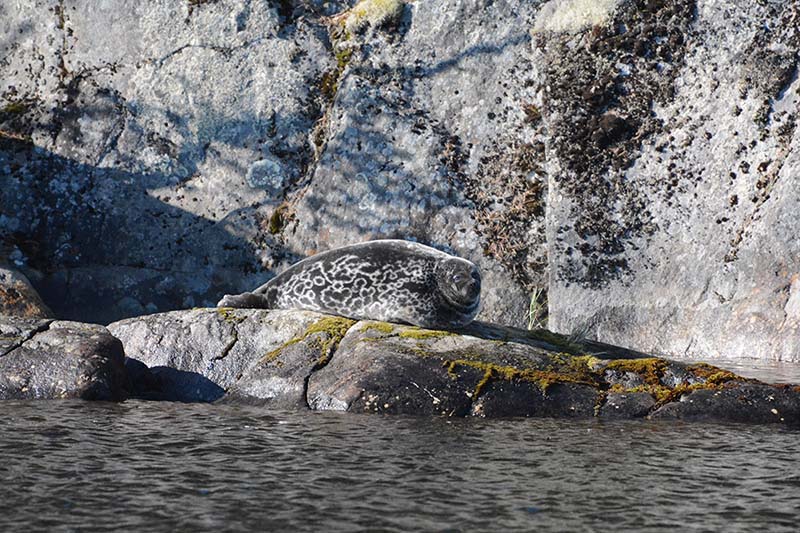Metsähallitus released the 2024 Saimaa ringed seal population estimate today, which suggests a total of slightly under 500 individuals. Due to continued conservation efforts, the population has been growing, though the increase remains slow. Growth is primarily occurring in the waters south of Savonlinna, while numbers north of Savonlinna have remained stable. Mild winters continue to threaten the breeding habitat increasing pup mortality.

Metsähallitus estimates the Saimaa ringed seal population for 2024 to be around 495 individuals. This estimate reflects the population at the beginning of the year, excluding pups born in the spring. The population assessment is an expert estimate mainly based on lair census results and supplemented by various observations.
Based on lair counts conducted in spring 2024, it is estimated that 95 Saimaa ringed seal pups were born this year, a figure consistent with the previous years, where the annual number of pups has ranged between 90 and 100. However, despite this usual number of births, the age group of 2024 remains small, because already 29 percent of the pups born this year have been found dead. The majority of these deaths occurred within the first few weeks due to poor nesting conditions.
Changes in Population Size Are Observed with a Delay
Recorded mortality for 2023 was 31 seals, an exceptionally high number. Of these, 29 percent died before weaning, and 26 percent drowned in fishing gear. The cause of death could not be determined for 42 percent, and one seal died from a generalized infection. However, the actual mortality is estimated to be up to three times higher, as only a small portion of wildlife deaths are observed and reported. The high number of observations may partly be due to chance, such as the increased likelihood of Lake Saimaa visitors finding dead seals and reporting them to Metsähallitus.
Changes in the Saimaa ringed seal population are always seen with a delay. For example, the impact of pup mortality on population growth becomes apparent approximately 4–6 years after the birth, when seals reach sexual maturity. The current population is significantly affected by the weather conditions of the winter of 2020. That winter was exceptionally mild, resulting in high pup mortality caused by lack of snowdrifts for seal lairs.
Population Development Shows Regional Differences
The Saimaa ringed seal population has, as a whole continued its slow recovery, though there are distinct differences between regions. In the population monitoring areas south of Savonlinna, the growth has been steady and stable. However, the population has not grown in the northern areas of Savonlinna over the last six years. Currently, about one-third of the Saimaa ringed seals live north of Savonlinna, but in 2010, 44 percent of the total population inhabited the same area.
“It is very concerning that population growth of the Saimaa ringed seal has stalled in the northern parts of Lake Saimaa, where approximately one third of the population lives. The reason for the slowed growth in the northern areas is currently unknown,” says Miina Auttila, a senior conservation specialist at Metsähallitus Parks & Wildlife Finland.
Conservation Efforts for the Saimaa Ringed Seal Must Continue
The greatest threats to the Saimaa ringed seal include the deterioration of breeding habitat due to climate change and shoreline construction, as well as drowning in fishing gear. The low number of the seal individuals and decreasing genetic diversity also threaten its ability to survive in a changing environment. Although conservation efforts have increased the population over the past decades, the Saimaa ringed seal remains endangered and dependent on continued protection.
Metsähallitus is responsible for monitoring the Saimaa ringed seal population and for a significant portion of conservation efforts. More than 300 local volunteers participate annually in monitoring and various conservation actions, such as lair counting and the shoveling of man-made snowdrifts to provide lair sites for the seals.
Data for the population estimate is obtained from annual nest counts and reported dead seals. Observations of seals lying on the ice and the University of Eastern Finland’s photo-ID data, which identifies individuals based on their fur patterns, are also used.
The Our Saimaa Seal LIFE project is preparing for a warming climate by developing monitoring and conservation methods.
Follow the Saimaa Ringed Seal through the Norppatilanne Service
Metsähallitus’ Norppatilanne service displays population estimates, birth and mortality statistics, and new data on man-made snowdrifts. Numbers related to population size, birth rates, mortality, and causes of death can be explored by different regions and time periods.
Visit the service: metsa.fi/norppatilanne, in Finnish
More information
- Population monitoring: Metsähallitus, Nature Services: Miina Auttila, Conservation Specialist, tel. +358406376324, email in the format firstname.lastname@metsa.fi
- Nest counts, additional snowdrifts, and dead seals: Metsähallitus, Conservation Specialist Riikka Alakoski, tel. +358405307241, email in the format firstname.lastname@metsa.fi
- Our Saimaa Seal LIFE
- Saimaa Ringed Seal Population Monitoring (in Finnish)
The attached table presents the birth rates for 2024 and an estimate of the winter population size by monitoring area.
| Water Area | Pups Observed | Pups Estimated | Estimated Winter Population Size |
|---|---|---|---|
| Pyhäselkä-Jänisselkä | 0 | 0 | 7 |
| Orivesi | 0 | 1 | 12 |
| Pyyvesi-Enonvesi | 1 | 1 | 9 |
| Kolovesi | 2 | 2 | 15 |
| Joutenvesi | 3 | 4 | 30 |
| Haukivesi | 15 | 17 | 90 |
| Pihlajavesi | 33 | 39 | 170 |
| Puruvesi | 4 | 4 | 17 |
| Tolvanselkä-Katosselkä | 8 | 8 | 48 |
| Luonteri | 5 | 5 | 14 |
| Lietvesi | 4 | 4 | 23 |
| Petraselkä-Yövesi | 6 | 7 | 40 |
| Suur-Saimaa | 3 | 3 | 20 |
| Total | 84 | 95 | 495 |